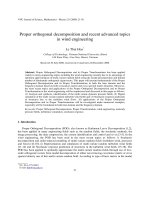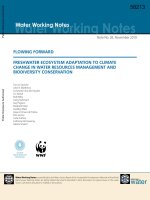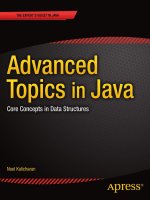advanced topics in information resources management. volume 2
Bạn đang xem bản rút gọn của tài liệu. Xem và tải ngay bản đầy đủ của tài liệu tại đây (2.12 MB, 385 trang )
Advanced Topics in
Information
Resources
Management
Volume 2
Mehdi Khosrow-Pour, D. B. A.
Information Resources Management Association
Hershey • London • Melbourne • Singapore • Beijing
IDEA GROUP PUBLISHING
Senior Editor: Mehdi Khosrow-Pour
Senior Managing Editor: Jan Travers
Managing Editor: Amanda Appicello
Development Editor: Michele Rossi
Copy Editor: Maria Boyer
Typesetter: Jennifer Wetzel
Cover Design: Integrated Book Technology
Printed at: Integrated Book Technology
Published in the United States of America by
Idea Group Publishing (an imprint of Idea Group Inc.)
701 E. Chocolate Avenue, Suite 200
Hershey, PA 17033-1240
Tel: 717-533-8845
Fax: 717-533-8661
E-mail:
Web site:
and in the United Kingdom by
Idea Group Publishing (an imprint of Idea Group Inc.)
3 Henrietta Street
Covent Garden
London WC2E 8LU
Tel: 44 20 7240 0856
Fax: 44 20 7379 3313
Web site:
Copyright © 2003 by Idea Group Inc. All rights reserved. No part of this book may be repro-
duced in any form or by any means, electronic or mechanical, including photocopying, without
written permission from the publisher.
Advanced Topics in Information Resources Management is part of the Idea Group Publishing series
named Advanced Topics in Information Resources Management Series (ISSN 1537-9329)
ISBN 1-59140-062-7
eISBN 1-59140-099-6
British Cataloguing in Publication Data
A Cataloguing in Publication record for this book is available from the British Library.
NEW from Idea Group Publishing
Excellent additions to your institution’s library! Recommend these titles to your Librarian!
To receive a copy of the Idea Group Publishing catalog, please contact (toll free) 1/800-345-4332,
fax 1/717-533-8661,or visit the IGP Online Bookstore at:
[]!
Note: All IGP books are also available as ebooks on netlibrary.com as well as other ebook sources.
Contact Ms. Carrie Skovrinskie at [] to receive a complete list of sources
where you can obtain ebook information or IGP titles.
• Digital Bridges: Developing Countries in the Knowledge Economy, John Senyo Afele/ ISBN:1-59140-039-2;
eISBN 1-59140-067-8, © 2003
• Integrative Document & Content Management: Strategies for Exploiting Enterprise Knowledge, Len Asprey
and Michael Middleton/ ISBN: 1-59140-055-4; eISBN 1-59140-068-6, © 2003
• Critical Reflections on Information Systems: A Systemic Approach, Jeimy Cano/ ISBN: 1-59140-040-6; eISBN
1-59140-069-4, © 2003
• Web-Enabled Systems Integration: Practices and Challenges, Ajantha Dahanayake and Waltraud Gerhardt
ISBN: 1-59140-041-4; eISBN 1-59140-070-8, © 2003
• Public Information Technology: Policy and Management Issues, G. David Garson/ ISBN: 1-59140-060-0;
eISBN 1-59140-071-6, © 2003
• Knowledge and Information Technology Management: Human and Social Perspectives, Angappa Gunasekaran,
Omar Khalil and Syed Mahbubur Rahman/ ISBN: 1-59140-032-5; eISBN 1-59140-072-4, © 2003
• Building Knowledge Economies: Opportunities and Challenges, Liaquat Hossain and Virginia Gibson/ ISBN:
1-59140-059-7; eISBN 1-59140-073-2, © 2003
• Knowledge and Business Process Management, Vlatka Hlupic/ISBN: 1-59140-036-8; eISBN 1-59140-074-0, ©
2003
• IT-Based Management: Challenges and Solutions, Luiz Antonio Joia/ISBN: 1-59140-033-3; eISBN 1-59140-
075-9, © 2003
• Geographic Information Systems and Health Applications, Omar Khan/ ISBN: 1-59140-042-2; eISBN 1-59140-
076-7, © 2003
• The Economic and Social Impacts of E-Commerce, Sam Lubbe/ ISBN: 1-59140-043-0; eISBN 1-59140-077-5,
© 2003
• Computational Intelligence in Control, Masoud Mohammadian, Ruhul Amin Sarker and Xin Yao/ISBN: 1-59140-
037-6; eISBN 1-59140-079-1, © 2003
• Decision-Making Support Systems: Achievements and Challenges for the New Decade, M.C. Manuel Mora,
Guisseppi Forgionne and Jatinder N.D. Gupta/ISBN: 1-59140-045-7; eISBN 1-59140-080-5, © 2003
• Architectural Issues of Web-Enabled Electronic Business, Nansi Shi and V.K. Murthy/ ISBN: 1-59140-049-X;
eISBN 1-59140-081-3, © 2003
• Adaptive Evolutionary Information Systems, Nandish V. Patel/ISBN: 1-59140-034-1; eISBN 1-59140-082-1, ©
2003
• Managing Data Mining Technologies in Organizations: Techniques and Applications, Parag Pendharkar/
ISBN: 1-59140-057-0; eISBN 1-59140-083-X, © 2003
• Intelligent Agent Software Engineering, Valentina Plekhanova/ ISBN: 1-59140-046-5; eISBN 1-59140-084-8, ©
2003
• Advances in Software Maintenance Management: Technologies and Solutions, Macario Polo, Mario Piattini and
Francisco Ruiz/ ISBN: 1-59140-047-3; eISBN 1-59140-085-6, © 2003
• Multidimensional Databases: Problems and Solutions, Maurizio Rafanelli/ISBN: 1-59140-053-8; eISBN 1-
59140-086-4, © 2003
• Information Technology Enabled Global Customer Service, Tapio Reponen/ISBN: 1-59140-048-1; eISBN 1-
59140-087-2, © 2003
• Creating Business Value with Information Technology: Challenges and Solutions, Namchul Shin/ISBN: 1-
59140-038-4; eISBN 1-59140-088-0, © 2003
• Advances in Mobile Commerce Technologies, Ee-Peng Lim and Keng Siau/ ISBN: 1-59140-052-X; eISBN 1-
59140-089-9, © 2003
• Mobile Commerce: Technology, Theory and Applications, Brian Mennecke and Troy Strader/ ISBN: 1-59140-
044-9; eISBN 1-59140-090-2, © 2003
• Managing Multimedia-Enabled Technologies in Organizations, S.R. Subramanya/ISBN: 1-59140-054-6; eISBN
1-59140-091-0, © 2003
• Web-Powered Databases, David Taniar and Johanna Wenny Rahayu/ISBN: 1-59140-035-X; eISBN 1-59140-092-
9, © 2003
• E-Commerce and Cultural Values, Theerasak Thanasankit/ISBN: 1-59140-056-2; eISBN 1-59140-093-7, ©
2003
• Information Modeling for Internet Applications, Patrick van Bommel/ISBN: 1-59140-050-3; eISBN 1-59140-
094-5, © 2003
• Data Mining: Opportunities and Challenges, John Wang/ISBN: 1-59140-051-1; eISBN 1-59140-095-3, © 2003
• Annals of Cases on Information Technology – vol 5, Mehdi Khosrowpour/ ISBN: 1-59140-061-9; eISBN 1-
59140-096-1, © 2003
• Advanced Topics in Database Research – vol 2, Keng Siau/ISBN: 1-59140-063-5; eISBN 1-59140-098-8, ©
2003
• Advanced Topics in End User Computing – vol 2, Mo Adam Mahmood/ISBN: 1-59140-065-1; eISBN 1-59140-
100-3, © 2003
• Advanced Topics in Global Information Management – vol 2, Felix Tan/ ISBN: 1-59140-064-3; eISBN 1-
59140-101-1, © 2003
• Advanced Topics in Information Resources Management – vol 2, Mehdi Khosrowpour/ ISBN: 1-59140-062-7;
eISBN 1-59140-099-6, © 2003
Advanced Topics in
Information Resources
Management
Volume 2
Table of Contents
Preface vii
Mehdi Khosrow-Pour, Information Resources Management
Association
Chapter I. Aligning IS Research and Practice: A Research Agenda for
Virtual Work 1
France Bélanger, Virginia Polytechnic Institute and
State University, USA
Mary Beth Watson-Manheim, University of Illinois at Chicago, USA
Dianne H. Jordan, Science Applications International, Inc., USA
Chapter II. The Societal Impact of the World Wide Web–Key
Challenges for the 21st Century 32
Janice M. Burn, Edith Cowan University, Australia
Karen D. Loch, Georgia State University, USA
Chapter III. Internet Privacy: Interpreting Key Issues 52
Gurpreet S. Dhillon, University of Nevada, Las Vegas, USA
Trevor T. Moores, University of Nevada, Las Vegas, USA
Chapter IV. Knowledge Management Enablers within an
IT Department 62
Hope Koch, Texas A&M University, USA
David Paradice, Florida State University, USA
Yi Guo, Texas A&M University, USA
Bongsug Chae, Kansas State University, USA
Chapter V. E-mail’s Value: Internal versus External Usage 91
Denise J. McManus, Wake Forest University, USA
Chetan S. Sankar, Auburn University, USA
Houston H. Carr, Auburn University, USA
F. Nelson Ford, Auburn University, USA
Chapter VI. The Value of Managerial Flexibility in Strategic IT
Investment: Identify the Real Options of Resource Allocation 111
Xiaotong Li, University of Alabama in Huntsville, USA
John D. Johnson, University of Mississippi, USA
Chapter VII. Trust and Technology in Virtual Teams 133
Steven A. Morris, Middle Tennessee State University, USA
Thomas E. Marshall, Auburn University, USA
R. Kelly Rainer, Jr., Auburn University, USA
Chapter VIII. An Architecture for Active and Passive Knowledge
Management Systems 160
Stuart D. Galup, Florida Atlantic University, USA
Ronald Dattero, Southwest Missouri State University, USA
Richard C. Hicks, Texas A&M International University, USA
Chapter IX. Social Issues in Electronic Commerce: Implications for
Policy Makers 173
Anastasia Papazafeiropoulou, Brunel University, UK
Athanasia Pouloudi, Athens University of Economics and
Business (AUEB), Greece
Chapter X. Information Technology Outsourcing in Australia 192
Nicholas Beaumont, Monash University, Australia
Christina Costa, Monash University, Australia
Chapter XI. Exploring the Influence of Rewards on Attitudes Towards
Knowledge Sharing 220
Gee Woo (Gilbert) Bock, National University of Singapore,
Singapore
Young-Gul Kim, Korea Advanced Institute of Science and
Technology, Korea
Chapter XII. Intentions to Use Groupware: The Influence of Users’
Perceptions 238
Craig Van Slyke, University of Central Florida, USA
Hao Lou, Ohio University, USA
John Day, Ohio University, USA
Chapter XIII. The Influences of the Degree of Interactivity on
User-Outcomes in a Multimedia Environment: An Empirical
Investigation 258
William D. Haseman, University of Wisconsin-Milwaukee, USA
Vichuda Nui Polatoglu, Anadolu University, Turkey
K. Ramamurthy, University of Wisconsin-Milwaukee, USA
Chapter XIV. On the Role of Human Mortality in Information System
Security: From the Problems of Descriptivism to Non-Descriptive
Foundations 301
Mikko T. Siponen, University of Oulu, Finland
Chapter XV. Chaos Theory as a Framework for Studying Information
Systems 320
Gurpreet S. Dhillon, University of Nevada, Las Vegas, USA
John Ward, Cranfield School of Management, UK
Chapter XVI. Organizational Mission Statements: A Postmodernist
Perspective on the Management of an IS/IT Function 338
John Pillay, Manchester Metropolitan University, UK
Ray Hackney, Manchester Metropolitan University, UK
About the Authors 355
Index 368
Preface
vii
Information management has many facets, and the emerging world of elec-
tronic business and virtual communities makes the tasks associated with effective
information management even more complex. From knowledge management to
virtual teams and from IT investments to organizational mission statements, busi-
ness executives, IT practitioners, researchers, teachers and students need to have
access to the most current information surrounding the research and practice of
information resources management. The chapters offer the most current theory
and practice in IT research and management. These chapters, all written by ex-
perts in their respective fields offer concrete suggestions for managers and indi-
viduals who want to get the most from their IT investments, secure their privacy on
the Internet and effectively manage their knowledge resources. For the academics
and researchers, these chapters offer novel theory of evaluating information sys-
tems. From postmodernism to Chaos Theory, these chapters are designed to
provoke thoughtful discussion and novel research paradigms.
Chapter I, entitled “Aligning IS Research and Practice: A Research Agenda
for Virtual Work,” by France Bélanger, Mary Beth Watson-Manheim and Diane
H. Jordan, explores the emerging area of virtual work. This chapter develops a
new and broader research agenda that accounts for emerging issues and concerns
of practitioners, existing published work and interdisciplinary perspectives in the
area of virtual work. The authors of this chapter offer an intriguing discussion of
the emerging trends in virtual work and the necessary supporting technologies.
Chapter II, entitled “The Societal Impact of the World Wide Web — Key
Challenges for the 21st Century,” by Janice M. Burn and Karen D. Loch, ad-
dresses the impact of information technology and the World Wide Web on the
21st century and the challenges that responsible members of a dynamically chang-
ing society face in light of these new technologies. The authors argue that organi-
zational, sociological and cultural factors may inhibit an effective transformation to
a global information society and pay particular attention to the policies, infrastruc-
ture, human resources and development responsibilities in developing countries.
Chapter III, entitled “Internet Privacy: Interpreting Key Issues” by Gurpreet
S. Dhillon and Trevor T. Moores, identifies issues related to maximizing Internet
viii
privacy. This chapter describes the notion of Internet privacy and offers various
researchers’ definitions of it. The authors then describe their research, which sought
to define the major Internet privacy concerns. The chapter presents five major
areas of concern, and the authors offer the recommendations for ensuring privacy
in the Internet age.
Chapter IV, entitled “Knowledge Management Enablers within an IT De-
partment,” by Hope Koch, David Paradice, Yi Guo and Bongsug Chae, presents
a case study of knowledge management efforts within an information technology
environment. The case study is based on technical and human-centric approaches
combined with Holsapple and Joshi’s Kentucky Initiative. Based upon the case
study presented, the authors propose a model of execution of knowledge manipu-
lation activities and a model outlining factors enabling effective knowledge man-
agement.
Chapter V, entitled “E-mail’s Value: Internal versus External Usage,” by
Denise J. McManus, Chetan S. Sankar, Houston H. Carr and F. Nelson Ford,
provides a new perspective on the competitive advantage of electronic mail within
organizations. This chapter investigates the relationship between the strategic uses
and competitive benefits of electronic mail in modern organizations. The results
suggest that e-mail usage could augment the competitive posture of the firm.
Chapter VI, entitled “The Value of Managerial Flexibility in Strategic IT In-
vestment: Identify the Real Options of Resource Allocation,” by Xiaotong Li and
John D. Johnson, discusses the real options theory and its application to IT invest-
ment evaluation. The authors provide a framework that systematically justifies
using real options theory in Strategic IT investment evaluation. The authors dis-
cuss an electronic brokerage’s investment decision in wireless technology as a
real-world application of the proposed framework.
Chapter VII, entitled “Trust and Technology in Virtual Teams,” by Steven A.
Morris, Thomas E. Marshall and R. Kelly Rainer, Jr., investigates the impacts that
reliance on information technology and trust have on job satisfaction of virtual
team members. The study presented in the chapter reveals that both user satisfac-
tion and trust are positively related to job satisfaction in virtual teams, while system
use was not found to play a significant role.
Chapter VIII, entitled “An Architecture for Active and Passive Knowledge
Management Systems,” by Stuart D. Galup, Ronald Dattero and Richard C. Hicks,
discusses the importance of utilizing a knowledge management system which al-
lows for knowledge management activities that utilize both active and passive
knowledge. This chapter develops and justifies a proposed client/server architec-
ture to build a manageable active knowledge management system that uses digital
forms of both active and passive knowledge.
ix
Chapter IX, entitled “Social Issues in Electronic Commerce: Implications for
Policy Makers,” by Anastasia Papazafeiropoulou and Athanasia Pouloudi, exam-
ines how social concerns such as trust and digital democracy pertain to all levels of
Internet and electronic commerce policy. The authors then discuss dilemmas fac-
ing and influencing the development and construction of an effective and socially
responsible strategy for electronic commerce.
Chapter X, entitled “Information Technology Outsourcing in Australia,” by
Nicholas Beaumont and Christina Costa, reports a research project investigating
the incidence of outsourcing among Australian firms. The authors conclude that
the three most important factors for driving outsourcing in Australia are access to
skills, improved service quality and increasing mangers’ ability to focus on core
business activities. The chapter concludes by offering suggestions for successful
outsourcing partnerships.
Chapter XI, entitled “Exploring the Influence of Rewards on Attitudes To-
wards Knowledge Sharing,” by Gee Woo (Gilbert) Bock and Young-Gul Kim,
describes the results of a study that examines and tests factors expected to affect
an individual’s knowledge-sharing attitudes, intentions and behaviors in an organi-
zational context. The chapter discusses the major detriments towards knowledge
sharing and the influence of a positive attitude towards knowledge-sharing behav-
iors.
Chapter XII, entitled “Intentions to Use Groupware: The Influence of Users’
Perceptions,” by Craig Van Slyke, Hao Lou and John Day, presents the results of
a study using diffusion of innovation theory to investigate the factors that influence
intentions to use a specific groupware application, Lotus Domino discussion data-
base. The authors offer suggestions for positively impacting users’ perceptions
and increasing the use of groupware applications.
Chapter XIII, entitled “The Influences of the Degree of Interactivity on User-
Outcomes in a Multimedia Environment: An Empirical Investigation,” by William
D. Haseman, Vichuda Nui Polatoglu and K. Ramamurthy, investigates the influ-
ence of interactivity on the learning outcomes of users in a multimedia systems
environment. The results of the study discussed indicate that while interactivity
does not necessarily enable a gain in user learning, it does positively influence
participants’ attitudes. The study further demonstrates that there are no moderat-
ing effects of learning styles, as measured by Kolb’s Learning Style Inventory
scale, on the relationship between interactivity and user outcomes.
Chapter XIV, entitled “On the Role of Human Morality in Information Sys-
tem Security: From the Problems of Descriptivism to Non-Descriptive Founda-
tions,” by Mikko T. Siponen, proposes that the use of ethical theories and human
morality is useful for security, and further argues that descriptivism, including cul-
tural relativism, leads to several problems and contradictions, and causes detri-
x
mental effects to well-being and security. The authors propose an alternative ap-
proach to using ethics that is based upon non-descriptive theories.
Chapter XV, entitled “Chaos Theory as a Framework for Studying Informa-
tion Systems,” by Gurpreet S. Dhillon and John Ward, introduces Chaos Theory
as a means of studying information systems. The chapter argues that new tech-
niques, derived from Chaos Theory and used for discovering patterns in complex
quantitative and qualitative evidence, offers a more sustentative approach to un-
derstand the nature of information systems.
Chapter XVI, entitled “Organizational Mission Statements: A Postmodernist
Perspective on the Management of an IS/IT Function,” by John Pillay and Ray
Hackney, examines postmodernism in the context of organizational mission state-
ments and forms a critique of modernist approaches and proposes alternative
views about philosophy, organizational management theory and IS/IT manage-
ment theory. The authors conclude that the modernist/postmodernist dialectic is a
productive discussion, which positively contributes to IT research in terms of ana-
lytical techniques and interpretive strategies.
Effective and efficient management of information and knowledge resources
is priority for organizations of all types and sizes, and for individuals. The increas-
ing importance of the virtual world is revolutionizing the way businesses and orga-
nizations relate to each other. In order to be successful in this technological world,
organizations, researchers, teachers, students and individuals must have access to
the most current research into the theory and practice of information management.
Academics and researchers will find the research proposed an excellent starting
point for discussions and springboard for their own research. Practitioners and
business people will find concrete advice on how to maximize their IT invest-
ments, their knowledge management initiatives and their training programs. This
timely new book is a must-read for anyone interested in gaining a better under-
standing of how to successfully manage and improve their valuable technology
and information resources.
Mehdi Khosrow-Pour
Information Resources Management Association
January 2003
Aligning IS Research and Practice 1
Copyright © 2003, Idea Group Inc. Copying or distributing in print or electronic forms without written
permission of Idea Group Inc. is prohibited.
Chapter I
Aligning IS Research and
Practice: A Research
Agenda for Virtual Work
1
France Bélanger
Virginia Polytechnic Institute and State University, USA
Mary Beth Watson-Manheim
University of Illinois at Chicago, USA
Dianne H. Jordan
Science Applications International, Inc., USA
ABSTRACT
Recent advances in information technologies have led organizations to
diversify their organizational structures. One of the most prominent trends in
this diversification is to conduct work in distributed or virtual environments.
Distributed work alternatives are numerous, but the common characteristic
that defines these alternatives is the physical separation of employees from
each other and/or their organization’s workplace. Several corporations have
reported their efforts, successes and failures at implementing some form of
distributed work. Practitioners face a number of issues when considering
2 Bélanger, Watson-Manheim & Jordan
Copyright © 2003, Idea Group Inc. Copying or distributing in print or electronic forms without written
permission of Idea Group Inc. is prohibited.
virtual work alternatives. However, research does not seem to successfully
help in understanding and solving some of these key issues. This chapter
attempts to develop a new and broader research agenda that takes into
account emerging issues and concerns of practitioners, existing published
work and interdisciplinary perspectives on the topic. In doing so, emerging
trends in virtual work and supporting technologies are explored.
INTRODUCTION
Virtual or distributed work environments are increasingly employed by
organizations. These environments include geographically distributed work teams,
global project teams, inter-organizational teams and non-traditional work environ-
ments such as virtual organizations, telecommuting (telework), hoteling and satellite
work centers. While there is increased complexity and potential for problems,
virtual work strategies allow organizations a great deal of flexibility to compete in
a rapidly changing business environment. Existing research provides insights into
distributed work environments, but does it deal with the major concerns and issues
faced by managers? What problems need to be addressed before organizations can
take better advantage of today’s technologies in distributing their workforce? It
seems that research has not been successful at understanding and solving some of
the key issues that practitioners face when considering virtual work alternatives
(“the gap”).
A gap between research and practice has always existed since the two areas’
interests have different roots. Practicing managers are concerned with current
challenges in their particular work settings, while academics are concerned with
developing more generalizable rules and understanding. In addition, there is an
inherent time lag between the surfacing of challenges in the day-to-day activities of
managers and the development of academic research addressing these concerns
and challenges. While academics focus on understanding virtual work environments
and practitioners focus on managing these environments, our discussions and
research about this gap reveal that it is inappropriately large. This chapter has three
objectives: 1) to examine the gap between research and practice in virtual work; 2)
to investigate the factors leading to this gap; and 3) to identify a research agenda to
address emerging issues and concerns relevant to practice in virtual work. We
proceed by identifying current concerns of practitioners through descriptions of two
companies’ virtual work environments. We compare them with published research
to establish the extent of the gap and then investigate the reasons for this gap.
Aligning IS Research and Practice 3
Copyright © 2003, Idea Group Inc. Copying or distributing in print or electronic forms without written
permission of Idea Group Inc. is prohibited.
METHODOLOGY
Our study includes three steps. First, we reviewed the recent literature on
virtual work and included a discussion of early work in the area of telecommuting
and telework. Second, we compared the topics identified in our literature review
with issues raised by practitioners in two organizations. Finally, we identified and
discussed the gap found between the two views (academic and practitioner), and
developed an agenda for future research.
VIRTUAL WORK LITERATURE
One of the biggest problems in conducting or discussing research on distrib-
uted work is the abundance of definitions and terms used interchangeably (Bélanger
& Collins, 1998; McCloskey & Igbaria, 1998; Pinsonneault & Boisvert, 2001).
While there are other distributed work arrangements such as hoteling, neighbor-
hood work centers and flextime, most of the literature has focused on telecommuting
(telework) and virtual teams/organizations. There is overlap between these terms,
and this is part of the difficulty with conducting research in the area. We use the term
“virtual work” to represent work environments where individuals spend some time
working in non-face-to-face (FTF) mode, using information and communication
technologies to perform work activities.
In order to identify relevant academic research on telework and virtual work,
we employed two different methods. First, we searched a number of sources for
articles. We performed searches on ABI/Inform using the keywords virtual work,
distributed work, telework and telecommuting. We concentrated on the years
1998 to 2001 since research prior to 1998 has been summarized in several recent
literature reviews (discussed in a later section). We focused on mainstream IS
journals targeted to the MIS community.
2
In addition, we investigated the Academy
of Management journals and Organization Science. Finally, we included special
issues of several journals and books published between 1998 and 2001.
Second, we used the “snowball” technique where we mined citations in articles
for further references. We did not include the large number of papers presented at
conferences.
Other studies relevant to teleworking and virtual work can be found in the
transportation, organizational behavior, ethics, law, sociology and communication
literatures. We limited our sample to employees of organizations who perform their
work at home, or in other remote work settings during at least some normal business
hours. Therefore, studies of home-workers and entrepreneurs are not included, nor
4 Bélanger, Watson-Manheim & Jordan
Copyright © 2003, Idea Group Inc. Copying or distributing in print or electronic forms without written
permission of Idea Group Inc. is prohibited.
Authors Type of
Research
Methodology Sample
Key Concepts
Adam 2001 Empirical Survey &
interviews
14 organizations & 20
teleworkers
Provides descriptive statistics on the use of telewor
king in Ireland.
Ahuja &
Carley
1998
Empirical Analyzed e-
mail messages
from a 3-month
period
Researchers, graduate
students & staff at
various universities &
corporations
Studied communication patterns. Found that
hierarchical tendencies emerged. Also degree of task
routineness influenced development of hierarchica
l tendencies (more routine led to more hierarchy).
Bélanger &
Collins
1998
Conceptual Literature
review
7 empirical hypothesis-
driven & 25 empirical
not hypothesis-driven
studies
Presents literature before
1998 and discusses need for proper definitions.
Proposes a framework where
organizational, individual, work and technology chara
cteristics must fit together in affecting
telecommuting outcomes (at societal, organizationa
l and individual levels).
Bélanger
1999
Empirical Survey &
interviews
76 telecommuters &
non-telecommuters
Discusses reasons individuals opt not to telecommut
e. Choice is significantly impacted by job type and
age of individuals. Telecommuters report highe
r perceived productivity and personal control than non-
telecommuters.
Bélanger
1999b
Empirical Survey 75 co-worke
rs including
some telecommuters
Using network analysis, studied whether non-telec
ommuters form their own cliques, with
telecommuters being left out of office networ
k. Results indicate that telecommuters and non-
telecommuters do not form separate groups, and
that only job type tends to indicate clique or sub-
group membership.
Bélanger et
al. 2001
Empirical Survey 8 work groups i
n 6
organizations; 67
telecommuters & 33
non-telecommuters
Availability of information system and communication t
echnologies positively impact productivity,
performance and satisfaction of telecommuters. The
fit (interaction) between information systems and
communication technologies available reduces th
e positive impact of technologies on productivity.
The level of workgroup communication negatively affe
cts perceived productivity and performance.
Boudreau et
al. 1998
Conceptual Informal
review of
literature
Addresses virtual transnationa
l organizations. Proposes framework to match inform
ation technologies
to requirements of virtual transnational organizations f
or efficiency, responsiveness and learning.
Cascio
2000
Conceptual Informal
review of
literature
Identifies and examines diffe
rent forms of virtual workplace. Propose management gui
delines. Most
important to shift from emphasis on time to e
mphasis on results, and require better supervisory skills
from managers. Number of managers needed
should not decrease.
Table 1: Review of Recent Literature – Summary
Aligning IS Research and Practice 5
Copyright © 2003, Idea Group Inc. Copying or distributing in print or electronic forms without written
permission of Idea Group Inc. is prohibited.
Table 1: Review of Recent Literature – Summary (continued)
Dimitrova
& Salaff
1998
Empirical Survey 94 teleworkers in
1 firm Employees with more complex, interdepende
nt networks and who deal in “softer,” more p
olitical
information rely most on phone communication; ot
hers rely most on e-mail.
Dixon &
Webster
1998
Empirical Survey 119 telecommute
rs Higher organizational support results in lowe
r stress levels. Stress has strong inverse relationship wit
h
quality of work & non-work life. Telecommuters &
non-telecommuters report similar stress levels, but
from different source.
Duxbury
1998
Empirical Survey 2 department
s
Part-time telework arrangements do not seem to im
pact intra-organizational communications.
Duxbury &
Neufeld
1999
Empirical Survey 36 teleworkers, 28
managers, 27 co-
workers, 25 in control
group
Teleworkers did not differ from the control group in
terms of frequency with which they
communicated with managers, subordinates, co-worker
s and clients.
Duxbury et
al. 1998
Empirical Surveys &
interviews at
two time
periods
54 telecommuters, 26
managers, 22 co-
workers,
36 in control group
Teleworkers had significant difference in work-fami
ly conflict over time with lower levels of
interference of family to work and work to family, and f
ewer problems managing family time than
before telework pilot. Control, co-worker and mana
ger groups had no significant differences.
Telework can help balance work and family demands.
Goodman
& Darr
1998
Empirical
60 sites of Fortune 100
company
Investigated organizational learning in distributed e
nvironment. Found that technology was not well-
suited for complex problems. Alternatives suc
h as meetings were best to filter best practices.
Grabowski
& Roberts
1998
Conceptual Literature
review
Investigated virtual organizat
ion risk propensity. Identified 4 factors that m
itigate risk propensity:
organizational structuring and design, communi
cation, culture and trust.
Guthrie &
Pick 1998
Empirical Survey 134 manage
rs &
professionals
Presented with 18 telecommuting scenarios, opinions of
respondents revealed that there were no
differences in their views of telework and wor
k ethics as a function of organizational level,
telecommuting experience and gender.
Guimaraes
& Dallow
1999
Empirical Survey 316 telecom
muters in
18 companies
Characteristics of supervisors, employees, tasks and w
ork environment, management support and
problems encountered affect telecommuting su
ccess.
6 Bélanger, Watson-Manheim & Jordan
Copyright © 2003, Idea Group Inc. Copying or distributing in print or electronic forms without written
permission of Idea Group Inc. is prohibited.
Table 1: Review of Recent Literature – Summary (continued)
Harrington
& Ruppel
2001
Empirical Survey 125 IS managers
Investigated effects of practi
cal compatibility and values comp
atibility on telecommuting adop
tion,
diffusion and success. Findings indicate that ability
to secure telecommuting and developmental values
affect adoption and diffusion of telecommuting, gr
oup values affect diffusion and success of
telecommuting, and practical compatibility and rat
ional values affect telecommuting success.
Harrington
& Ruppel
1999
Empirical Survey 111 IS mana
gers Measured effects of trust, corporate cultur
e (4 levels), practical compatibility and relative
advantage on
telecommuting adoption, diffusion and success. Tr
ust affects adoption and diffusion, relative
advantage affects all 3 outcomes and various levels
of corporate culture affect the 3 outcomes.
Hightower
et al. 1998
Empirical 3 experiments Students in 3-
person
groups; number of
groups unknown
Discusses the effects of Computer Mediated C
ommunication Systems (CMCS) on information
exchange in groups. Findings indicate that ad hoc vi
rtual groups exchange information less effectively
than face-to-face groups. Ongoing virtual gro
ups exchange information more effectively than ongoing
face-to-face groups.
Igbaria &
Guimaraes
1999
Empirical Survey 400 salespeople i
n 1
large organization;
compared answers of
telecommuters &
regular employees
Examined the role of the work environment on t
urnover intentions, role stressors, e.g., role ambiguity
and role conflicts, job satisfaction and organizationa
l commitment. Found that telecommuters seemed
to have less role conflict, exhibited higher job s
atisfaction and were more committed to the
organization.
Jarvenpaa
& Leidner
1999
Empirical Case studies
(e-mail archives,
questionnaires)
350 Master’s-level
students from 28
universities around the
world
Trust in temporary global virtual teams. Does
it exist, how is it developed, what communication
behaviors facilitate
development of trust? Found that if trust is developed, it
is early in the life of the
team—“swift trust.”
Jarvenpaa
et al. 1998
Empirical Content analysis
of interactions
over 8 weeks
75 teams comprised of
4 -6 students residing in
different countries
Examined antecedents of team trust development. Ea
rly phase of team development, trust influenced
strongest by perception of members’ integrity and least
by perception of benevolence. Influence of
perception of ability of members on trust decrease
d over time.
Johnson
2001
Empirical Case
1 organization (St. Paul
Companies)
Case looks at St. Paul Companies’ use of the virtual
office. Overall use of telecommuting is positive,
and there is a recognition of the need for more
training.
Kavan &
Saunders
1998
Empirical Survey 1 organization, se
veral
managers
Employee approval and suitability of the alte
rnative work arrangement programs correlate
significantly to the likelihood of their adoption. Ma
nagers with lower performance on budgets and
employee satisfaction tend to view the adopti
on of part-time and job-sharing programs as more likely.
Aligning IS Research and Practice 7
Copyright © 2003, Idea Group Inc. Copying or distributing in print or electronic forms without written
permission of Idea Group Inc. is prohibited.
Table 1: Review of Recent Literature – Summary (continued)
Knight &
Westbork
1999
Empirical Survey 20 teleworker
s Found that Hertzberg’s motivation facto
rs (achievement, recognition, work itself, responsibil
ity,
advancement and growth) apply to teleworkers
.
Knoll &
Jarvenpaa
1998
Empirical Content
analysis,
surveys &
interviews
Study 1: 12 teams (84
students); Study 2: 7
teams (30 students)
Collaboration, conflicts, communication and social
ization in virtual teams (using electronic mail).
Kraut et al.
1999
Empirical Telephone
survey
Senior managers in 250
firms
Coordination in supply chain. What are mecha
nisms for coordination? Personal relationships
complement electronic coordination mechanisms/ne
tworks. Firms more likely to use e-mail than
computer networks for exchanging documents;
use of networks associated with poor outcomes in
working with suppliers.
Lind 1999 Empirical Survey
29 virtual groups of 4 &
1 virtual group of 5
students
Looked at perceptions of face-to-face vs. virtual g
roups based on gender. In virtual groups, women
perceived that the groups stuck together more th
an the men, and were more satisfied and found group
conflicts to be more readily resolved than men
. Face-to-face women were less satisfied with grou
p
experience than virtual counterparts.
Majchrzak
et al. 2000
Empirical Observations,
surveys,
content
analysis, in 10-
month
longitudinal
study
1 inter-organizational
virtual team
Knowledge sharing through communication te
chnology. Found that CT use decreased over time, b
ut is
used more when collective understanding is requi
red. Knowledge sharing is more complex than
current models predict. Sharing of different typ
es of knowledge—content and process—differs
depending on context-specific needs.
Maznevski
& Chudoba
2000
Empirical Qualitative
longitudinal
field study,
multiple data-
gathering
methods
3 globally distributed
teams in 1 organization;
2 of 3 teams had
members from outside
organization—a
strategic partner
Influence of structural characteristics of teams (t
ask, group and technology) as antecedents of the
influence of team interactions (decision proce
sses, message complexity and form) on performance
outcomes. Effective interaction is composed of mu
ltiple incidents, which fit different aspects of team’s
structural characteristics. Also, face-to-face commu
nication was critical, often essential, to effective
performance; and communication regularity influenc
ed effectiveness.
McCloskey
& Igbaria
1998
Conceptual
Literature
review
32 studies
Review of telecommuting literature revealed on
ly 32 empirical studies. Studies include pilot studie
s, usage
studies, beliefs/perceptions studies, work a
ttitudes/outcome studies and family issue studies. Is
sues include
definitions of telecommuting, methodological w
eaknesses and lack of control of extraneous factors.
8 Bélanger, Watson-Manheim & Jordan
Copyright © 2003, Idea Group Inc. Copying or distributing in print or electronic forms without written
permission of Idea Group Inc. is prohibited.
Table 1: Review of Recent Literature – Summary (continued)
McCloskey
2001
Empirical Survey 89 telecomm
uters & 71
nontelecommuters
Telecommuters report more autonomy, less time-ba
sed work-family conflict and receiving less career-
support than non-telecommuters.
Palmer
1998
Empirical
Survey 55 technology managers
Use of IT is different in virtual organizations than vi
rtual teams in regular organizations. Greater use of
Web but lower use of groupware, EDI and e-
mail.
Pinsonn-
eault &
Boisvert
2001
Conceptual Literature
review
Starts by reviewing definitions. Identifies all positive
and negative impacts of telecommuting for
organizations and individuals.
Reinsch
1999
Empirical Quasi-
experiment
104 telecommuters Communication be
haviors and relationship duration affect participation in
a telecommuting program.
Managerial reaction to criticism and manageri
al loyalty significantly affected forecasts of the worker’
s
and manager’s working together successfully.
Ruppel &
Howard
1998a &
1998b
Empirical Survey 252 IS manage
rs Top management support, champions, ad
equate security measures and manager training were
positively related to telework adoption ad diffus
ion.
Scott &
Timmer-
man 1999
Empirical Survey 86 teleworkers
Investigated relationship between teleworker
s demographics, communication technology use,
identification and level of virtuality of teleworkers. F
ound non-linear relationship between level of
telecommuting and identification with team, or
ganization and occupation. Moderate levels of
telecommuting (21-50% of the time) have higher l
evels of identification. Some demographics also
impact communication technology use or identificatio
n.
Staples
2001
Empirical Focus groups 5 organizations, 19
focus groups & 104
people (appx.); half
managers, half
teleworkers; follow-up
survey of 631 managers
& employees
The main issues in management of remote work
ers were identified using two different scores. The top
issues were communications, performance managem
ent, coaching, information technology and
isolation. Survey results indicate the strongest
predictor of effectiveness of telecommuting include
managers’ ability to assess performance based on r
esults and communicating goals and setting
priorities, employees’ ability to set objectives
that align with their managers’ and the length of time
employees have worked for their managers.
Staples et
al. 1999
Empirical Questionnaire
376 remotely managed
employees in 18 diverse
organizations
Investigated management of remote employees usi
ng self-efficacy theory. Found that training, IT
support and work experience are important fo
r individuals working remotely.
Aligning IS Research and Practice 9
Copyright © 2003, Idea Group Inc. Copying or distributing in print or electronic forms without written
permission of Idea Group Inc. is prohibited.
Table 1: Review of Recent Literature – Summary (continued)
Turner et
al. 1998
Empirical Case
1 case
Evaluation of features for a collaborative not
ebook in virtual workpl
aces. Takes i
nto account patterns
of work and information flow. Adoption of notebook w
as slow. Individuals perceive their patterns of
work differently than what they really are.
Fritz et al.
1998
Empirical Questionnaire 230 employ
ees in 9
firms with ongoing
telecommuting
programs
Examined influence of job characteristics, IT suppor
t and coordination methods on communication
satisfaction for telecommuters and traditional of
fice workers. Found task predictability positively
influenced satisfaction for telecommuters. S
upport for and use of IT positively influenced satisf
action
for both groups.
Wiesenfeld
et al. 1999
Empirical Survey 325 employ
ees, sales
team in large
international company
Mediating effect of virtual status (# of days in of
fice) on relationship between communication mode
and organizational identification. Found that e
-mail communication is critical for those out of the
office often, to create and sustain organizational
identification. Phone communication more important
for those not out of the office as often. FTF w
as not strongly related.
are studies of supplemental work at home. Finally, in selecting our sample we
focused on empirical and/or theoretically grounded studies.
After we collected the relevant papers
based on the above criteria, we summarized the
key elements found in each paper. Table 1
presents this summary. Using the information in
the table, we identified the key issues discussed
in the literature, and organized the papers and
our discussion around these issues.
Findings from Literature Review
The review of recent literature (1998 to
2001) revealed 41 empirical and/or theoreti-
cally grounded studies that fit the above criteria.
Six were literature reviews and 35 were empiri-
cal studies. Overall, these 41 articles address
the following questions:
• Who are the virtual workers?
• How is communication influenced by vir-
tual work?
• What technologies are used and how do
they influence virtual work outcomes?
• What is the nature of the work-family
conflict in virtual work?
• What are the outcomes of virtual work
environments?
• What happens in virtual group work?
• What are key issues in the management of
remote workers?
Who are the Virtual Workers?
There are two types of studies that discuss
who virtual workers are. The first type is de-
scriptive, usually presenting demographics and
other characteristics of virtual workers based
on general surveys or public records. Examples
include a survey of telework in Ireland (Adam,
2001) and a study of telework in an organiza-
10 Bélanger, Watson-Manheim & Jordan
Copyright © 2003, Idea Group Inc. Copying or distributing in print or electronic forms without written
permission of Idea Group Inc. is prohibited.
tion (Johnson, 2001). There were a large number of such studies prior to 1998. The
second type of studies investigates characteristics of telecommuters. These studies
include factors leading to adoption/diffusion of teleworking (Harrington & Ruppel,
1999, 2001; Kavan & Saunders, 1998; Ruppel & Howard, 1998a, 1998b), the
relationships between demographics and aspects of telework (Bélanger, 1999;
Knight & Westbork, 1999; Scott & Timmerman, 1999) or individual factors
affecting telecommuting success (Reinsch, 1999). Again, similar studies were
conducted prior to 1998.
How is Communication Influenced by Virtual Work?
The area of communication has been the most researched in recent years. The
published work comprises studies of communication patterns and studies of
choices of communication modes. Research on communication patterns of virtual
workers focuses on variables that may affect how virtual workers communicate
with one another. In a study of the emergent organizational structure of a virtual
group of researchers, graduate students and staff at universities and corporations
working together to develop an artificial intelligence system architecture, findings
indicate that, contrary to widespread predictions of decentralization and flatness in
organizational structure, there were hierarchical tendencies in the group. These
tendencies were more pronounced for more routine tasks (Ahuja & Carley, 1999).
Bélanger (1999b) studied communication patterns of co-workers where some
worked at the office and others did not. Job type influenced who telecommuters
communicated with most, but telecommuters and non-telecommuters did not differ
on whom they communicated with, suggesting that telecommuters were not left out
of the office network. This result is similar to that of another study where teleworkers
did not differ on their frequency of communication with managers, subordinates, co-
workers and clients (Duxbury & Neufeld, 1999). Fritz et al. (1998) also found that
the support for, and use of, information technology positively impacts satisfaction
with communication for both telecommuters and non-telecommuters. However,
task predictability influenced satisfaction only for telecommuters.
The second type of communication studies focused on choice of communica-
tion mode. One study found that high virtual status employees (those out of the office
most often) found e-mail more useful in developing organizational identification than
low virtual status employees who relied more on the telephone for communication
(Wiesenfeld et al., 1999). Another study looking at knowledge sharing between
geographically distributed sites of a Fortune 100 company revealed that technology
is not well-suited to solve complex problems, and face-to-face communication is
needed to disseminate best practices (Goodman & Darr, 1998). Personal relation-
ships complement electronic coordination mechanisms in the performance of
Aligning IS Research and Practice 11
Copyright © 2003, Idea Group Inc. Copying or distributing in print or electronic forms without written
permission of Idea Group Inc. is prohibited.
production steps outside a firm’s boundaries in a supply chain (Kraut et al., 1999).
E-mail is the most-used communication mode by teleworkers. However, employ-
ees with complex, interdependent networks, who deal with more political informa-
tion, tend to rely more on the telephone for communicating (Dimitrova & Salaff,
1998). The use of electronic mail in telework and virtual teams was studied
extensively in pre-1998 literature.
What Technologies are Used and How do they Influence Virtual Work
Outcomes?
Prior to 1998, few studies investigated the use of technologies in virtual work
(an exception is Gupta et al., 1995). Recent studies of technologies for communi-
cation in virtual work include computer-mediated communication systems
(Hightower et al., 1998) and a collaborative notebook for virtual workplaces
(Turner et al., 1998). Palmer (1998) found virtual organizations used the Web more
than regular organizations, but made lower use of groupware, EDI and e-mail.
Bélanger et al. (2001) found that the availability of information systems and
communication technologies significantly positively affected productivity, perfor-
mance and satisfaction of telecommuters, while high levels of required work group
communication negatively affected perceived productivity and performance. An-
other study revealed communication technology is used less over time after a virtual
team has been established, but tends to be used more when a collective understand-
ing is required (Majchrzak et al., 2000). It is clear that many more questions need
to be answered, such as what other technologies are effective at supporting virtual
workers.
What is the Nature of the Work-Family Conflict in Virtual Work?
Duxbury and colleagues published a number of studies on the potential
conflicts between family and work roles of teleworkers. One of these is included
in the literature review in Table 1 (Duxbury et al., 1998), but several other studies
have been published prior to 1998, or in non-IS mainstream journals. Others have
also looked at aspects of the work-family conflict issue (Dixon & Webster, 1998;
Donaldson & Weiss, 1998).
What are the Outcomes of Virtual Work Environments?
Most hypotheses-driven studies used outcomes of virtual work, such as
productivity, satisfaction, or level of communication, as dependent measures.
Potential outcomes were also discussed extensively in pre-1998 literature. For
teleworkers, these outcomes include feelings of isolation, less commute time, more
personal control, more or less job satisfaction, more or less work-family conflicts,
12 Bélanger, Watson-Manheim & Jordan
Copyright © 2003, Idea Group Inc. Copying or distributing in print or electronic forms without written
permission of Idea Group Inc. is prohibited.
more productivity and many more. For organizations, typical outcomes include
savings on office space, increased efficiency, lower turnover or higher employee
morale. McCloskey (2001) found that telecommuters reported more autonomy,
less time-based work-family conflict, and received less career support than non-
telecommuters. Another study of the effects of the work environment on turnover
intentions, role stressors, job satisfaction and organizational commitment revealed
that telecommuters had less role conflict, exhibited higher job satisfaction and were
more committed to the organization (Igbaria & Guimaraes, 1999).
What Happens in Virtual Group Work?
Studies of virtual groups include those investigating the existence and devel-
opment of trust in student teams who never met in a face-to-face setting (Jarvenpaa
& Leidner, 1999; Jarvenpaa et al., 1998), the development processes for student
teams (Knoll & Jarvenpaa, 1998) and perceptions of face-to-face vs. virtual
groups of students based on gender (Lind, 1999). As these were student teams, it
is unclear whether their findings are generalizable to the workplace, but they provide
insight for managers implementing temporary teams of geographically dispersed,
culturally diverse individuals. Maznevski and Chudoba (2000) intensively studied
three teams whose members were globally distributed, with most members based
in one firm, but some based in partner companies. Findings indicate face-to-face
meetings were sometimes essential to effective performance, and these meetings
and other communication modes were most effective when held on a regular basis.
What are Key Issues in the Management of Remote Workers?
Staples et al. (1999) investigated the management of remote employees in one
organization. They found training, work experience and IT support were important
factors influencing success. More recently, Staples (2001) used focus groups in
several organizations with follow-up surveys to identify key issues in the manage-
ment of remote workers. Results suggested communication, performance manage-
ment, coaching, information technology and isolation are the main management
issues.
Literature Prior to 1998
At least six pre-1998 literature reviews were published between 1998 and
2001 (Bélanger & Collins, 1998; Boudreau et al., 1998; Cascio, 2000; Grabowski
& Roberts, 1998; McCloskey & Igbaria, 1998; Pinsonneault & Boisvert, 2001).
Most of these reviews agreed that earlier studies lacked proper definitions of the
terms used. The meta analyses also revealed a lack of theoretical foundations and
Aligning IS Research and Practice 13
Copyright © 2003, Idea Group Inc. Copying or distributing in print or electronic forms without written
permission of Idea Group Inc. is prohibited.
hypothesis-driven empirical research, although more recent studies tended to be
hypothesis-driven. Studies investigated beliefs/perceptions about telecommuting,
level of usage, evaluations of work attitudes/outcomes and discussions/evaluations
of work-family issues, or were pilot studies. In addition, earlier studies were limited
because of weak methods such as small/poor samples and lacking control of
extraneous variables. Two literature reviews (Boudreau et al., 1998; Grabowski &
Roberts, 1998) focused mainly on virtual organizations, while the other four focused
on virtual work.
The early literature, which was primarily prescriptive, most often discussed
practical issues associated with setting up telecommuting programs. Some articles
warned of the risk of exploitation as individuals with lower bargaining power were
forced to work at home (DeSanctis, 1984), and of issues of work-family conflicts
for telecommuters (Duxbury et al., 1992). A number of management challenges
were identified in the early exploratory studies (Fritz et al., 1995), such as
requirements for changes in job design (Mehlmann, 1988; Olson & Primps, 1984)
and increased workload for managers (Ramsower, 1985). Personal characteris-
tics, such as time management (Katz, 1987), and interpersonal skills, such as
development of trust between manager and subordinate (Olson & Primps, 1984),
were found to be critical to the success of telecommuters. Other studies addressed
the use or design of technology in the distributed environment with respect to other
aspects of the work environment (e.g., task type, coordination activities) (Gupta et
al., 1995).
Summary
Our literature review shows that a number of barriers, enablers and outcomes
of virtual work have been studied. In recent years, communication patterns and
communication mode choice have been the most popular research areas in virtual
work. Most of the studies on virtual work have been conducted using field studies
in different virtual environments. The samples have often been limited, e.g., one
organization, which can limit the generalizability of the findings, although sample
sizes seem to be increasing in recent years. Given the complexity of organizations,
the current research seems to be narrowly focused.
CASE NARRATIVES
In order to investigate whether a gap exists between research and practice, we
present the following case narratives describing distributed work in two organiza-
tions. These distributed work situations represent two different, but very common,
14 Bélanger, Watson-Manheim & Jordan
Copyright © 2003, Idea Group Inc. Copying or distributing in print or electronic forms without written
permission of Idea Group Inc. is prohibited.
work situations found in companies today. Data was gathered for the cases from
interviews with a senior manager and a front-line employee from work groups in
each of the two companies. The information was recorded and then reviewed by
a second researcher. Discussions led to the identification of several recurring
themes, used to describe the cases. In addition, several important issues and
questions raised by practitioners were logged, and are presented in our discussion
section. The case descriptions were developed and analyzed collaboratively by the
academicians and practitioners.
Case 1. Booz Allen Hamilton, Inc.
Booz Allen Hamilton (BAH), headquartered in McLean, Virginia, is a global
management and technology consulting firm for industry and government. The firm
has two major business units—the Worldwide Technology Business and the
Worldwide Commercial Business—offering services in strategy, systems, opera-
tions and technology. The company has more than 8,000 full-time employees, with
more than 4,000 professionals specializing in various Information Technology (IT)
disciplines.
Distributed Teams
Within its Worldwide Technology Business (WTB) group, the IT practice is
geographically dispersed in many offices across several states. For example, the
Advanced Distributed Learning (ADL) delivery team within the IT practice has
personnel in McLean, Virginia; San Antonio, Texas; and Eatontown, New Jersey.
Using matrix management, distributed teams are formed with members who have
the best skills for the project being undertaken. Teams form around skill sets and
“capabilities,” i.e., the ability to successfully deliver a high-quality, high-impact
solution for the client.
The teams can be classified as functional teams, delivery teams, develop-
ment teams and external teams. Functional teams bring together subject matter
experts with the skill sets that match the client’s needs and requirements, regardless
of geographic location. When tasks require expertise outside of the functional team,
members from other areas are matrixed into the functional team to form a combined
delivery team. Development teams are brought together for proposal, marketing
or other business development tasks such as client management (there is no
immediate product delivery). These are cross-functional teams that include exper-
tise and client experience from every business function. Finally, external teams are
formed when BAH consultants work on a delivery with an external vendor/
contractor.









